« June 2005 | Main | August 2005 »
July 29, 2005
Finished Project
Here are some photos of our most recent finished project. Highlights include Flagstone Entrance Walkway, Brazilian Hardwood Deck and Railings, Copper Landscape Lighting, Flagstone Patios set in sand, Stone Pool Wall and Coping.
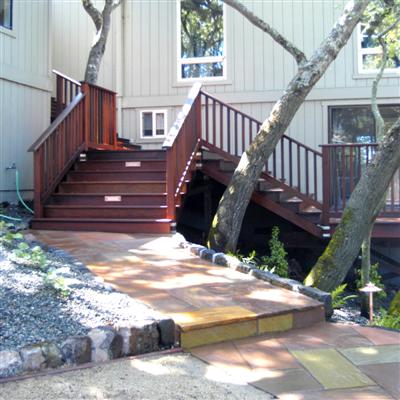
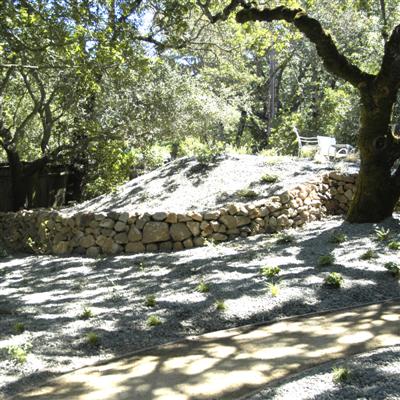
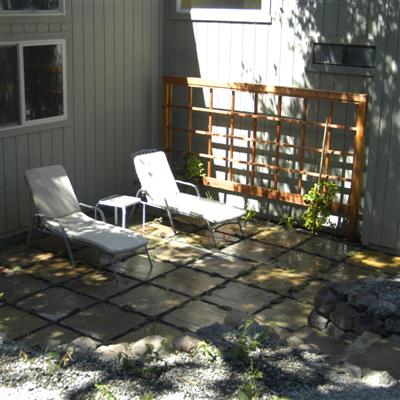
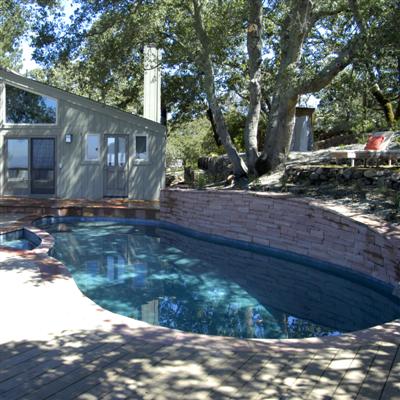
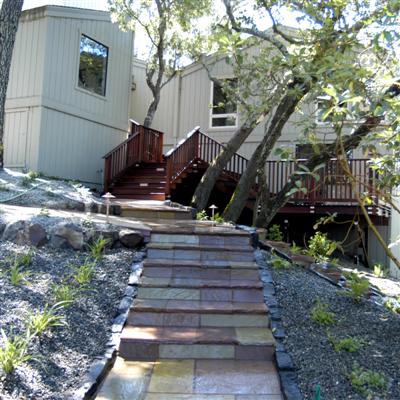
Posted by Michael O'Connell at 09:47 PM | Comments (0)
July 27, 2005
Pressure Washing
As we work to finish a project, we are doing some pressure washing of some existing wood railings, siding, and decking. It is amazing how the luster of wood can be brought back with some Wood Cleaner and a pressure washer.
Pressure washing is a good alternative to replacing old concrete, brick or wood in situations were the material is still sound, but has years of built up dirt, grime and wear. It is often amazing how good a material can look after some cleaning and pressure washing.
We often recommend this on flagstone installations, especially with softer stones, such as Arizona Flagstone, or in shady areas where moss, mildew and dirt may accumulate.

Posted by Michael O'Connell at 10:54 PM | Comments (0)
July 26, 2005
Scheduling your Irrigation in Hot Weather
As summer's heat hits throughout the nation, here are a few tips for making sure your plants endure the heat.
If you are watering by hand, especially with plants in pots, make sure to water frequently. Pots will dry out faster than in ground plantings. For sensitive soft stemmed plants, watering twice per day may be required in extreme heat. If you can move potted plants to protected or shaded areas this will help.
When setting your automatic irrigation controller keep in mind a few things:
1- Up the amount of water scheduled during hot periods
This can be done two ways- by either increasing the duration of the watering, or by increasing the frequency of the watering. If you lawn is on for 10 minutes normally, maybe up it to 15 minutes, or alternatively split it into two start times, one in the morning and one in the afternoon or evening for 6-7 minutes. Splitting watering into two cycles can improve water absorption into the soil, resulting in less run off and more effective watering.
2- Remember to check your settings
Observation is the key to watering. Once you make changes, make sure to keep an eye on things. It may need a bit more or less water depending on the circumstances. If you have upped the watering time for a hot period, remember to adjust it back down if cooler temperatures return.
Remember if you make changes to an automatic controller to set it back to Run or Automatic if required; a failure to do so will prevent the new settings from running, compounding the problem.
3- Probe the soil
A good way to check to see if plants are getting enough water is to probe the soil, brushing back any mulch around the plant and feeling a couple inches into the soil around the plant. The soil should be damp but not sopping wet. Remember that in situations with clay soils, that these typically have a greater water holding capacity and require less watering time. Another methodology for checking soil moisture is to buy a soil moisture probe.
Find more information:
Be Water Wise
East Bay MUD Newsletters
Posted by Michael O'Connell at 11:40 PM | Comments (0)
July 25, 2005
Bring Your Wood Back to Full Luster
Nothing can detract from woodwork, even a well constructed woodwork, like the gray tarnished look of weathering. There are several products available that can make an old wood look new.
Cleaner-Brighteners: These are effective one step products that both clean deposits and bring back the wood's natural color and beauty. There are several products available, one example is Behr's Cleaner-Brightener.
Oxalic Acid: This product is good to remove rust and other types of staining, wood bleeding from tannins (common with redwood), and nail or galvanized bleeding stains. Oxalic acid is often part of cleaner-brightener compounds as mentioned above. This product is also frequently called wood bleach.
These products can also be useful on new fence constructions. Often wood from the lumber yard may have bled, have marks from shipping straps or from being stacked outdoors.
After the wood has been cleaned, it is often a good idea to stain your newly cleaned fence to preserve its color. There are a wide variety of clear and colored stains available to preserve and protect the new wood look of your fence or wood work. Clear stains often look the best, when selecting a colored stain, make sure that the color is not too strong- this can make the fence stand out.
If you prefer the weathered look of wood, it is a good idea to treat your fence or wood to help prevent warping and aging. A good product is Seasonite.
For More Information:
Wood Care Products
Flood Company
Behr
Cabot Stains
Local Dealers:
Rafael Lumber
Marin Color Service
Posted by Michael O'Connell at 09:54 AM | Comments (0)
July 21, 2005
Nearing Completion
We have been working finishing a project up in Sonoma. One of the satisfying parts of completing projects is seeing all the parts of the project come together in a complete and unified whole.
This is especially true of larger scale projects, where a complete transformation is made over an entire property. As I was looking at the before photos of this particular project, I could not believe the difference. The transformative part of the process is always fun to see.
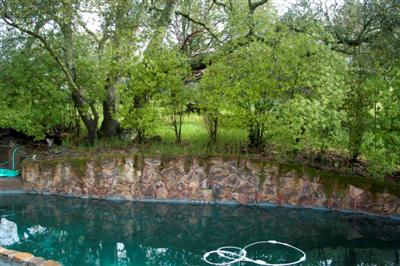
Pool Wall- Before Construction
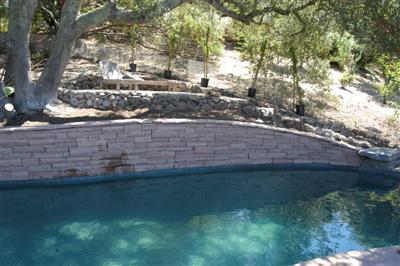
Pool Wall- After Construction
Posted by Michael O'Connell at 06:11 PM | Comments (0)
July 20, 2005
Nextel Service Update
We have been wrangling with Nextel customer care for the past week - see the last post. After doing a bit more research we are getting close to making the jump to Verizon. A good resource for those looking for cellular ratings would be the Consumer Reports Survey: the results are not shocking. Verizon was best in our area, and best nationally- Nextel, on the other hand, was rated worst nationally, with low levels of customer satisfaction. We can echo that sentiment.
Posted by Michael O'Connell at 06:41 PM | Comments (0)
July 19, 2005
Arizona Flagstone
Arizona flagstone is one of the most common and readily available stone materials (in California and the West at least). It is frequently used for patios and wall veneers. The stone comes in a variety of colors, mostly beige, pinks, reds, and oranges.
Arizona has the advantage of being one of the lowest cost stone materials, however if it is properly installed in irregular sheets it can often cost more than alternative stones materials that are installed in precut pieces. The material looks best when it is broken into inter-fitting pieces, which has an installation process much like a giant jig saw puzzle. Grout lines should be consistent, with small pieces avoided whenever possible to fill the intersections between stones.
Arizona flagstone is easy to work with, because it is quite soft. Dropping the material is often sufficient to break it. This makes cutting and chipping the stone easy, but exposes it to flaking and breaking. The material does respond well to pressure washing, which, depending on the area and exposure of the installation, can help bring the material back to full luster. It will slowly fade and lose color intensity over time.
The material is best used for patio and wall veneers, especially Arizona ledgestone, which makes a very handsome stone wall.
Visit our Stonework Portfolio for more image examples
Rosa Arizona Flagstone Patio & Steps
Sedona Red Arizona Flagstone Walkway & Steps
Classic Oak Arizona Flagstone Patio
Peach Arizona Ledgestone Wall
Posted by Michael O'Connell at 09:13 PM | Comments (1)
July 18, 2005
Problems with Nextel
Nextel has been the long time choice of many in the construction industry. Their walkie talkie feature made the beep-beep of Nextel phones common place on jobsites throughout the country. We have been Nextel customers for several years, our plan growing steadily over time to include more and more phones (we were laughing in the office the other day about how we ever got anything done in the days of pagers).
Our problems with Nextel recently started with one phone, (mine) going over its allotted minutes. We called Nextel to try to change the rate plan or add additional purchased minutes. We were curtly informed that they could make the change but it would not take effect until the next billing period. This, however, did not solve our problems, we needed extra minutes this month. The representatives at Nextel however hid behind their policy of no changes once the billing period has started (they no doubt relish the millions of dollars in overage charges they receive). After trying via email and on the phone to speak to a supervisor, we were again informed that no exception could be made.
That was fine for Nextel, but did not work well to meet our needs. So now we are looking at other cellular carriers, who will actually help us with our wireless service. Imagine if we had been a huge company with hundreds of phones; Nextel's policy may make their billing easier but it doesn't help their customers.
After checking around, both Verizon and Cingular do offer pro-rated plans, as did Nextel a few years ago. It's not that the policy was the problem, it was the impression that they did not care about our business.
The rest of the Nextel Series:
Nextel Service Update, Making the Switch to Verizon
Posted by Michael O'Connell at 06:03 PM | Comments (1)
July 15, 2005
Great People
Sometimes it is easy to take for granted the great people that work for you. We are working hard to complete a project and our crews have been great. They are working in 90+ degree heat all week, and they are really working to get the project done. There is never a complaint, and they work hard all day long.
I was out on the project site doing some site and design administration work and I was tired just watching our guys work, the sweat dripping off my face after briefly walking around the project.
Great people are the starting point, from there it is up to management to turn them into great results.
Posted by Michael O'Connell at 08:37 PM | Comments (0)
July 14, 2005
The Price of Steel
While working on a recent project we needed some custom fabricated stainless steel brackets to reinforce some work we were installing. For a few dozen brackets the cost came to over $1,000 for the materials alone. Our metal fabricator out of Chico, R&D Hydraulics, stated that the price of steel has skyrocketed in the past couple of years, costing almost twice what it would have cost. Pressure from the Chinese and other developing markets has driven the cost up.
Our particular incident is a microcosm of larger pressures on businesses reliant on steel. From our metal fabricator to the auto makers of Detroit, companies are scrambling to deal with the high cost of steel. Here is a good article from the Detriot Free Press detailing the problem.
Posted by Michael O'Connell at 08:02 PM | Comments (0)
July 13, 2005
Common Courtesy
Here is a bit of common courtesy that people soliciting any service should be aware of:
It happens more than you would think. A customer calls our company to his or her property for a free on-site consultation. From there often we compose a bid for landscape services to be done at the project. We send the bid, often via email.
And then we wait, and wait, and wait. It amazes me potential customers fail to follow up on estimates that we give. We issue the estimate and then they fall off the face of the earth. To me this is an issue of common courtesy. While I realize that potential clients are soliciting the services of our company and that the choice of companies is theirs, we often expend a lot of time and energy trying to be of service, even to those clients that do not hire us. For the sake of mutual courtesy all we would ask is an acknowledgement with a simple phone call or email stating that they decided to go with another company or in another direction.
Posted by Michael O'Connell at 09:33 AM | Comments (0)
July 12, 2005
A Guide to Concrete Finishes
Concrete is another material where I get frequent questions from clients asking about the range or choices for concrete finishes. The different types of concrete finishes come from different manipulations to the concrete surface and color. Here is a brief rundown of common finish types:
Exposed or Washed Concrete: The concrete (it can be colored or gray) is finished and typically treated with a surface agent. Once the concrete has had a sufficient chance to dry, the top layer of concrete is washed off to reveal the aggregate (sand & gravel). This finish is commonly used on city sidewalks, and makes for a high traction surface.
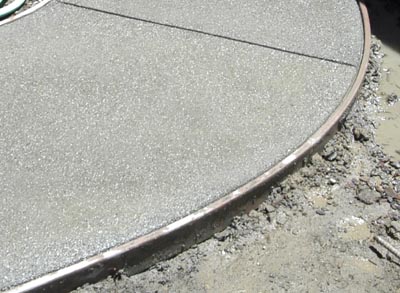
Close up of Exposed Concrete Surface
Heavier Exposure Concrete Driveway
Colored Concrete: Color concrete is achieved with a color pigment that is added directly into the concrete mixture (integral mix). There are a wide variety of earth toned concrete colors available. At times colored concrete can have some color variations and can fade and discolor over time. Colored concrete can be used with a surface treatment such as the exposed finish as detailed above.
To see available concrete colors visit:
Davis Colors or Scofield Color

Colored Concrete Driveway
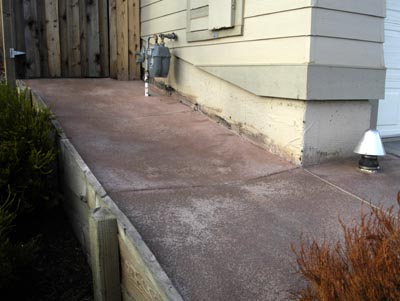
Colored concrete can become blotchy depending on a series of factors involving drying exposure, quality of finishing and amount of available moisture in the ground and added to the mix and the time of pouring.
Broom Finish: This is a standard concrete finish where the concrete is troweled to a smooth surfaced and then broomed to create a higher traction surface for outdoor applications. Smooth finished concrete (like a garage floor) should not be used for outdoor applications as it poses a safety risk when wet. Broom finishes are commonly seen in new developments on sidewalks and as a finish for colored concrete.
Broomed Color Concrete Patio
Salt Finish: This finish is often used around swimming pools, or in conjunction with terra cotta tile (think a Santa Barbara city Sidewalk). The concrete is finished smooth and then rock salt is added to the surface. When the concrete has set the rock salt is washed away leaving small pitholes in the concrete that create an interesting finish.
Seeded Aggregate: Concrete is finished and then small colored stones are packed by hand into the concrete surface. When the concrete has dried the top layer of concrete is washed away to reveal the stones. This is a popular finish for driveways. There are a variety of different pebble types that can be used to give different looks to the aggregate finish.
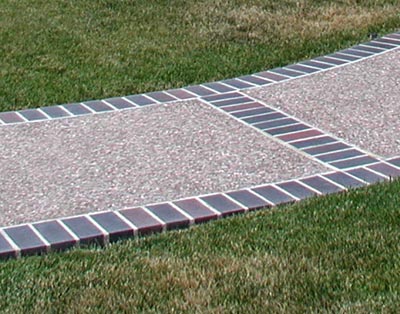
Aggregate Path with Brick Trim
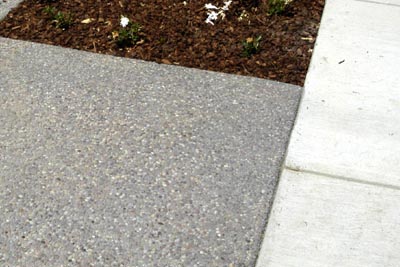
Aggregate finish adjacent to gray brushed concrete finish
Stamped Concrete: Stamped concrete is typically colored concrete applied by with special color and shape molds that give the concrete a different appearance. Typically the stamps imitate stone or tile patterns. Some can offer the look of stone at reduced cost. Stamped concrete is typically done by stamped concrete contractors who specialize in this type of installation. Bomanite is one company that has authorized dealers that install stamped and colored concrete using their particular stamp and color patterns.
Stained Concrete: Concrete staining is a surface treatment, where stains or dyes are applied to the surface of the concrete to improve or change its appearance. There are a lot more options for colors and patterns and textures with stained concrete. This is also something that can be done to existing concrete. Frequently, surface staining is done on interior floors (often in restaurants)
For more information on Concrete Types and Finishing Processes visit:
Concrete Network
A Quikrete Guide to Finishes
Posted by Michael O'Connell at 10:05 PM | Comments (2)
July 11, 2005
Many Choices in New Zealand Flaxes
I was at one of our main wholesale nursery suppliers last week leading clients on a tour for a planting design. One of the things that struck me while I was there was the amazing number of flaxes available.
For those not familiar with New Zealand Flax (Phormium sp.), they are a New Zealand native that are part of the Agave family. They grow best in the US along the coasts- throughout the Pacific Coast, Gulf Coast and Atlantic Coast up to Virginia.
New Zealand Flax is a versatile plant for California gardens. It's grassy strap like leaves help it fit well with a number of styles, especially Mediterranean compositions, and those using ornamental grasses.
Colors range from reds, purples, yellows, oranges and multicolors in sizes 18" and below to 10' and larger. Among those we use most are cultivars 'Dusky Chief,' 'Yellow Wave,' 'Tom Thumb' (Dwarf), 'Jack Spratt' (Dwarf) and a host of others. Cultivars are from two species Phormium cookianum and Phormium tenax.
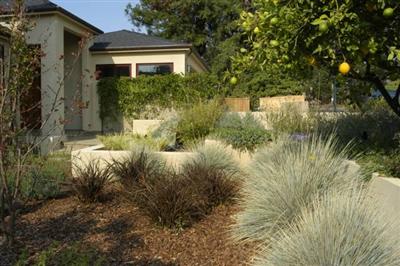
Dwarf Tom Thumb Flax mixed with Ornamental Blue Oat Grass
Find good links to images and more information at:
Monterey Bay Nursery Site
San Marcos Growers
Monrovia
Posted by Michael O'Connell at 09:59 PM | Comments (0)
July 09, 2005
Are Composite Decks the Best?
There was a great article in today's San Francisco Chronicle about composite decking versus traditional cedar and redwood decks- "All Decked Out".
Essentially, there are three drawbacks to composite products according to the article. Composite decking products are susceptible to mold, fade over time, and are susceptible to staining as well. The advantage to these materials is less maintenance and a longer useable lifespan.
I would add two other problems with composite decks. First, the composite materials do not have the same structural properties as wood. As a result all the structural framing (and sometimes railings) for the deck will need to be constructed out of regular lumber which will have a shorter lifespan than the decking boards above it. Second, the composite materials, while much improved since their introduction, do not replicate natural wood's appearance.
One final issue that the article points out: composite decking is not biodegradable. While it is true that composite decking is made of a high percentage of recycled plastic (such as grocery bags) and wood waste (saw dust), once the decking is disposed of after its useful life, it will be sent to the landfill where it will degrade at the same rate as other plastics. Natural wood on the other hand will rot and degrade naturally.
Posted by Michael O'Connell at 08:27 AM | Comments (0)
July 07, 2005
Automatic Gates
Wanted to share another local contractor we use for gate automation and entrance gates. We recently collaborated with Sculptural Gates out of Sonoma, California on a Brazilian Hardwood gate for a residence in Kentfield.
They have a great website with lots of gate related information and resources and a spin-off website for broader area sales- Gate Depot. They are a great resource for people interested in installing or purchasing an entrance gate.
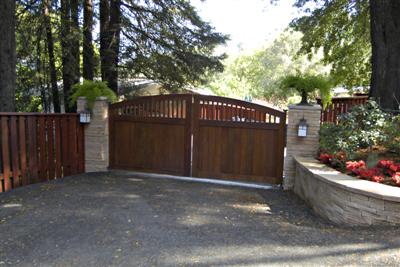
Brazilian Hardwood Entrance Gate-
Design and Construction Collaboration with Sculptural Gates, Sonoma CA
Posted by Michael O'Connell at 11:40 PM | Comments (0)
July 06, 2005
An Interesting Japanese Garden
There was an interesting article about Japanese gardens today in the San Francisco chronicle. Osmosis, a Japanese Spa retreat in Sonoma County has some beautiful Japanese gardens created by Osmosis founder Michael Stusser after a garden apprenticeship spent in Kyoto.
For good local examples of Japanese gardens this may be a good place to visit. The garden is only open to spa guests, except when they have special events, such as concerts- check the Chronicle Article for more details.
Making an authentic looking Japanese garden is not an easy task. I took a trip to Kyoto in 2001 and after seeing the real thing it is easy to spot imitators. You can view two of the better examples of Japanese Gardens in our Great Gardens portfolios for the Portland Japanese Gardens, and the San Francisco Japanese Tea House in Golden Gate Park.
Posted by Michael O'Connell at 12:11 PM | Comments (0)
July 05, 2005
Decomposed Granite Types
I received a question today about the types of available decomposed granite (DG). This can be a bit confusing because there are a few different options for DG.
DG is essentially a combination of small granite pieces and granite fines. The fines in the DG make the material well suited for pathways and areas where it can be compacted. Typically we compact our DG installations with a vibrating plate compactor.
DG comes in two basic color ranges, brown and gold. The material is usually installed one of three ways.
1. Decomposed Granite with no additives: The DG is often installed on a compacted base of roadbase gravel and then compacted to make a pathway, seating area, or other application. The DG is typically hard packed but can move and has a sandy consistency (what comes to mind is a French Park with its long sandy alees)
2. DG with stabilizer agent: A stabilizer agent is mixed into the DG which prevents the material from moving around as much and gives it a more hard packed appearance. The material will still form a bit of a sandy layer on the top but it is much better than the untreated DG.
3. DG with Resin or "Poly Pavement": The DG is mixed with a natural resin which creates a natural asphalt like material. This is the most expensive type of DG installation and we typically use it in high traffic areas, ramps and steps down hillsides, or driveway surfaces. It is frequently used in wineries for access paths and drives. The material will not run, and does not have a sandy consistency like the other types of DG.
While these additives make a great surface, the DG can become eroded if not protected from repeated water erosion. The most frequent culprit here is gutters or downspouts where constant dripping can erode the material.
DG is a great material where the design aesthetics are such where concrete would not work well or where a more rustic and natural look is desired. Both the untreated DG and the stabilizer will get somewhat muddy during rainy periods, so we recommend DG with resin for areas where access is heavy year round.
Below are some examples of the DG types:

Untreated DG Being Compacted
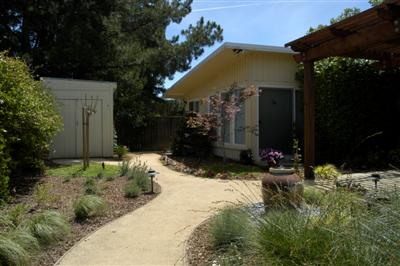
Decomposed Granite with Stabilizer Agent
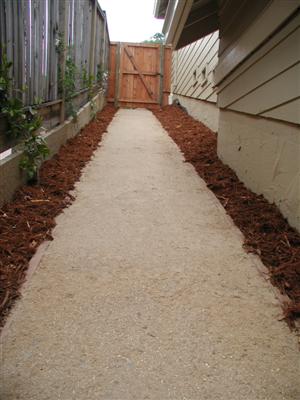
Decomposed Granite with Resin Additive
Used for Ramp pathway
Posted by Michael O'Connell at 10:41 PM | Comments (1)